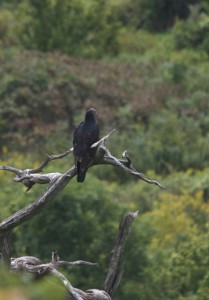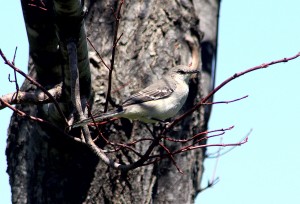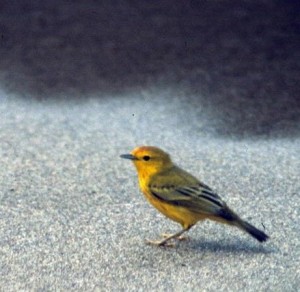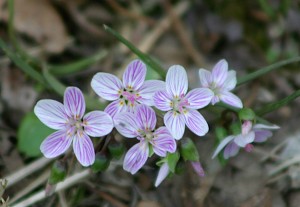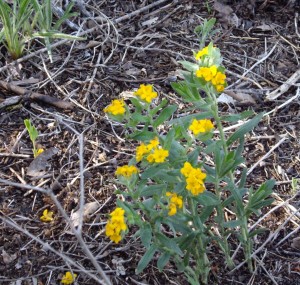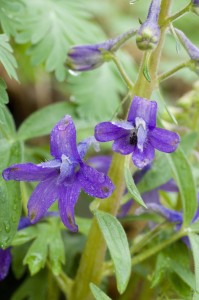Bluffs Alive with Spring Songs
By late April almost any patch of woods in our bluff lands comes alive with
bird song. The early-rising listener can hear night fade to dawn and catch the calls of owls as they head to daytime roosts and perhaps also hear the last songs of whippoorwills fading in the distance. But even while the birds of night remain active, other birds begin dawn song — a glorious, symphonic call and response of many different singers — about an hour before the sun begins to color the sky. In springtime, our resident birds are joined by migrants. Some of the migrants will stay for the summer, staking claims on territory, finding mates and raising a new generation, while members of some other species will pause here only briefly before heading further north. But, luckily for us, nearly every species — resident, temporary lodger, and migrants — will offer us a song.
Intriguing similarities between some elements of birdsong and human speech have been observed. Many baby birds, like human infants, babble bits and pieces and phrases as they learn and perfect their songs. And, both must hear adults in order to learn the correct manner of communication. Unlike humans, birds produce song through a completely different mechanism. Though analogous to a human larynx, the voice box — syrinx — of most birds is a dual structure and, for most species of songbirds, involves both elements
of the trachea and the upper bronchia. The number of muscle pairs — one to as many as eight — that work the syrinx are highest among the bird species that have the most elaborate songs. A few species, such as both Turkey and Black Vultures, have no functional syringeal muscles and are voiceless, capable only of low grunting noises.
Birds communicate many messages through call notes which are given by both males and females. Alarm, location, roosting, waking, even “good eats over here,” all can be heard from many birds throughout the year. Bird song, however, is mostly, but not exclusively, produced by males during the breeding season as they define and defend territory and seek a mate to join them. The males’ message, whether fluted, warbled, chirped, squawked, clucked, or whistled is “Choose me, choose me!”
The female’s choice may be influenced by the complexity and variety of song offered by a male. Mockingbirds continue to add to their song repertoire
throughout their lives, learning and mimicking songs from many other birds, and incorporating sounds made by other animals and even human machinery, such as gunfire, washing machines and emergency sirens. This skill offers apparent reproductive dividends, as older birds with song stocks numbering into the hundreds are more likely to attract and keep a mate than are young relatively song-poor birds.
The very variety of song can puzzle and frustrate the birder trying to learn “which song from what bird?” A very few species say their name. This naming for sound — technically called by the vowel twisting term onomatopoeia — has been used for common names of several species which, not surprisingly, have only a few frequently repeated songs. Eastern Phoebe repeatedly says “Fee-bee,” sometimes repeating “Fee-bee-bee-bee.” Echoing through the night, both our local nightjars Whippoorwills and Chuck-will’s-Widow, repeatedly call out their names. Chickadees, whether our local Carolina Chickadee or the slightly more northern species, Black-capped Chickadee, sing their name as they lead foraging bands through woodlots.
Other birds, at least according to writers of field guides, also sing in phrases we can recognize and memorize as guidance. This use of phrases or ideas to aid memory — a consonant challenged term called mnemonic — imposes an English translation onto the song phrases of various birds.
Mnemonic phrases have been coined for species as varied as their songs, and, sometimes, are phrases of instruction. American Robins, for example, instruct the listener to “cheerily cheer up, cheerio,” while the hidden bird that scratchily orders you to “Drink, drink, drink your teaeeeee,” is identified as an Eastern Towhee. Other song translations are descriptive, as a Yellow
Warbler sings “sweet, sweet. sweet, I’m so sweet,” or a Black-throated Blue Warbler confesses “I am so la-zee.” In some cases, the same song is assigned two different phrases, as White-throated Sparrows can be heard feeling sorry for “oh, poor Sam Peabody, Peabody, Peabody,” or, alternately, praising their summer breeding grounds with “my sweet Canada, Canada, Canada.”
Perhaps the phrases say as much about birders as birds. An eager birder perhaps hopes that a Chestnut-sided Warbler truly is so “pleased, pleased, pleased to meet -cha!” that the bird will show itself rather than just singing from the tree tops.
Or, perhaps, the references to tea — the towhee’s “drink tea,” or the phrase “teakettle, teakettle,” ascribed to either — or both — Carolina Wrens and Kentucky Warblers — may hint at the listeners’ need for a pickup beverage. More telling still may be the mnemonic references to beer, as the juncoe’s call notes sometimes are described, or as the Olive-sided Flycatcher calls for a set up of “quick, three beers!”
Whether beer or tea is one’s favorite tipple, springtime in the bluffs is a great time to hear the many-toned orchestra of bird song. And, Salt Lick Point is a marvelous place to explore the great outdoors of Monroe County. It and Fults Hill Prairie Nature Preserve — our two “crown jewels” of permanently protected bluff lands — both are open to the public.
Located between Old and New Valmeyer, the 450-acre tract looms 400 feet above the American Bottoms. Salt Lick is the highest point in Monroe County, at 810 feet elevation. The views are breathtaking.
Dedicated as a Land and Water Reserve a couple of years ago, Salt Lick Point features a mosaic of 12 high-quality hill prairies, seven lovely limestone glades, gorgeous racks of limestone bluffs, and stunning runs up upland forest. The Salt Lick Point Stewardship Committee and the Valmeyer Boy Scout Troop have labored hard at restoration efforts and recently have completed a mile-and-a-half public trail at the reserve.
By the end of April, spring ephemeral wildflowers — those that bloom, set seed, then fade away before the forest canopy shades the forest floor — still should be flowering. And, forest shade-tolerant and a few hill prairie plants will just be beginning to add color to our bluffs. About a dozen species of wildflowers should be easily found at Salt Lick Point at month’s end.
The delicate white flowers of Harbinger-of-Spring (Ereginia bulbosa) and dainty pink flowers of Spring Beauties (Claytonia virginica), both easy to overlook, can be found on moister slopes and ravines.
The small white flowers of the tiny Whitlow Grass (Draba cunifolia), an Alpine-like relic of the Ice Age and a rarity found only in Southwestern Illinois, still should be blooming on precipitous edges and ledges of the cliffs.
White-flowered Whorled Milkweed (Asclepias quadrifolia), the first milkweed to bloom each year, and another scarcity in our state, can be found in rocky, open areas of the woods.
Three species of yellow-flowered bloomers, a color more associated with midsummer, add diversity to the bluffscapes’ April palette. Bristly Buttercups (Ranunculus hispidus), each flower made up of five waxy-yellow petals, grow throughout the blufflands. Local Illini Native Americans made a poultice from its leaves to heal wounds.
Yellow-flowered Hoary Puccoon and Fringed Puccoon (Lithospermum canescens and incisum) should be blooming in hill prairies and glades by
late April. Later, when the plants have set seed, the meaning of the Latin name — “stone seed” — is apparent, for few seeds are protected by such a heavy, hard coating as these. The common name, spelled pocan by French translators of the Algonquin Indian word poughkone, means “blood red,” and was applied to plants which produce red juices. And, as with “bloodroot,” another early spring bloomer of our bluffs, both Yellow-Flowered Hoary and Fringed Puccoons, were gathered to extract a red dye from their roots.
Wild Geraniums (Geranium maculatum), with rose-lavender flowers, and widely used by early settlers as an astringent, can be spotted in the forests throughout the bluffs.
Four species of blue-blooming plants round out our bluffscapes’ flower tapestry in April. Violet Wood Sorrel (Oxalis violaceae), with shamrock-shaped leaves that fold down at night, grow on rocky, shaded slopes. Woodland Blue Phlox (Phlox divaricata) and Dwarf Larkspur (Delphinium
tricorne), with flowers shaded towards violet, grace the bases of moister slopes. And, Cleft Phlox (Phlox bifida) cling to the cliff faces, curtaining the ledges with sky-blue, pale-white, and lavender-pink foams of flowers.
A hike in the bluffs is a springtime joy of color and sound!
Clifftop, a local nonprofit organization, is focused on preserving and protecting area bluff lands.
A version of this article appeared in the April 9 2008 edition of the Monroe County Clarion.
© 2008 all content rights reserved, Clifftop NFP.
Comments are currently closed.


